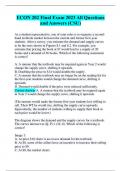Exam (elaborations)
ECON 202 Final Exam 2023 All Questions and Answers (CSU)
- Course
- Institution
ECON 202 Final Exam 2023 All Questions and Answers (CSU) As a student representative, one of your roles is to organize a secondhand textbook market between the current and former first-year students. After a survey, you estimate the demand and supply curves to be the ones shown in Figures 8.1 a...
[Show more]



